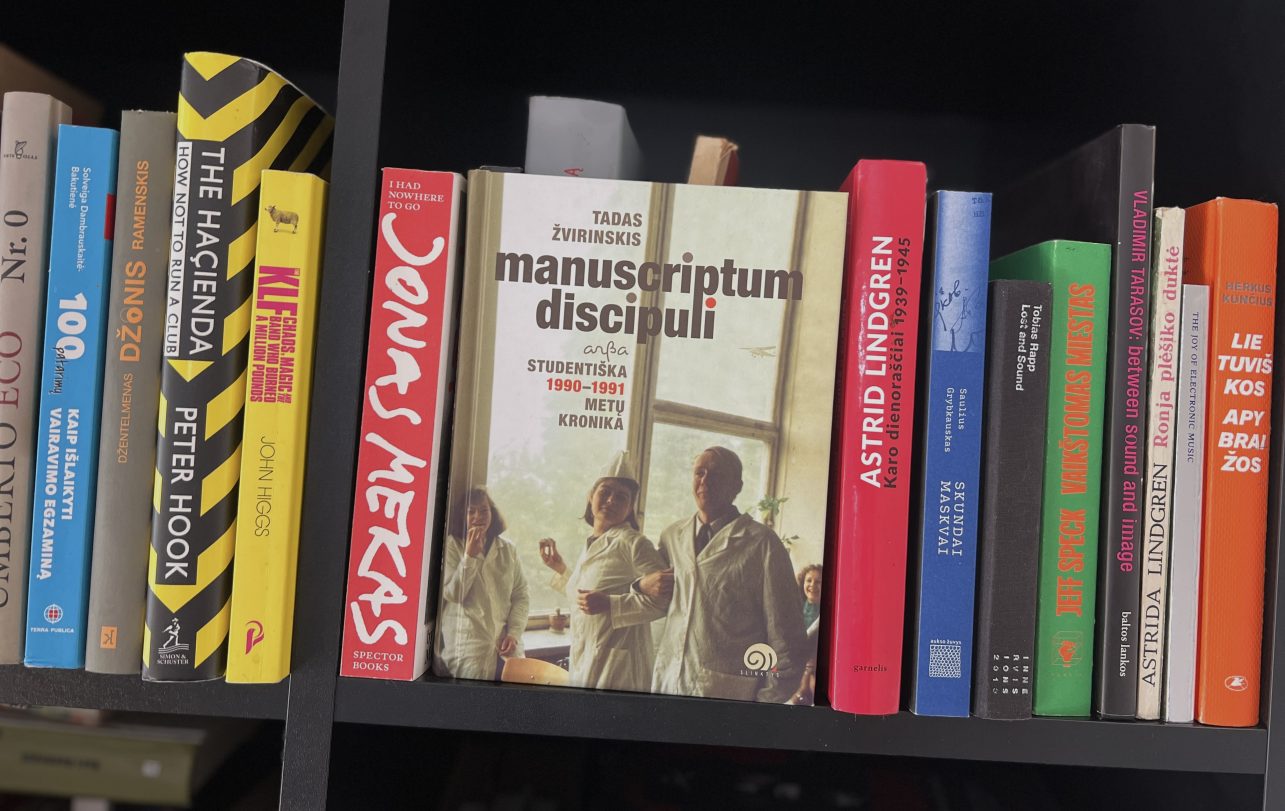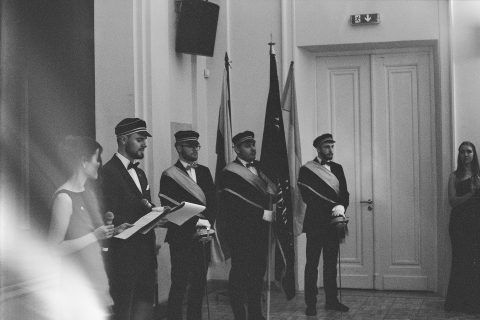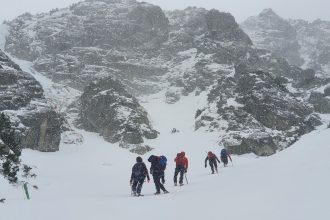During the occupation years, there were so few restaurants and other capitalist inventions in Kaunas that the celebrities of the time, such as Sabonis and Kurtinaitis, and the students just starting in life, frequented the same luxury spot Gildija. Legends are told about basketball players, but I learned more about the hobbies of “Medkė” (the Lithuanian University of Health Sciences) students quite by accident.
I was overwhelmed by the facts recounted by a young man, reflecting the turn of various eras, as described in Tadas Žvirinskis’ book Manuscriptum discipuli, or the Student Chronicle of 1990–1991 (Vilnius: Slinktys Association, 2021). I grabbed the book by chance as I was leaving the Kolibris bookstore –the owner was already prepared to return the remaining copies to the publisher, but after seeing my enthusiasm a couple of days later, he decided to hold off.
Tadas Žvirinskis is not only a writer, poet, and translator from Vilnius, but also an actual pharmacist who began his studies in Kaunas in 1987. Kaunas remained the city of his studies and love, making this diary-like novel, where real events intertwine with fantasy, a rather pure, unadulterated view of the city and its inhabitants as they approached independence, without being influenced by the current social and political situation. In the pages of Manuscriptum discipuli, a concise narrative unfolds, revealing not just the changes in time and regime, but also the inner transformation of a young person. In this respect, it is reminiscent of the recently published Robčik – by the same publishing house – by the Vilnius-based Polish author Bartosz Połoński. If Robčik can serve as an excellent guide to the Polish side of Vilnius, which is unfamiliar to many Lithuanians, then Manuscriptum discipuli is a wild taxi ride smelling of cheap alcohol and sweaty bodies to a time that, while inspiring and free in some respects, is thankfully a time that will never return. It also offers a glimpse into a version of Kaunas that will never exist again.
While reading the novel spanning two years, it is rather impossible to forget that the diary belongs to the pharmacy and not a history or engineering student. No, you won’t find experiments with opiates or detailed formulas, but there are a few meaningful things worth remembering. For example, the main character plans to “wash his legs with cold water” to fall asleep faster: apparently, this was the advice given to his friend by a physiology professor. The book also thoroughly explains what actually happens in the body when one receives what’s called a “stitch in the side”.

Heartache, an empty refrigerator, planned or spontaneous parties in the dormitory – such aspects of student life are typical of various eras. The book Manuscriptum discipuli is also full of these plotlines. There are parties “at the Natashas” or with the young dentistry students, and the protagonist is torn between two crushes (both classmates and future doctors, so dermatological elements also appear in the erotic passages). The relationship with food described here may be less familiar to modern readers, for example, the detailed description of a care package of treats sent to a friend in the army and a letter from a mother expressing joy over receiving cured meat as a gift. The diary captures the painful blows of the crumbling Soviet empire on the newly restored Lithuanian state, melting and devalued savings, and rumors that circulated even in the face of the new regime. For instance, the idea that every student, good or bad, would have to pay 50 rubles for their education.
“Perhaps the meaning of life is that you never run out of toothpaste,” muses the narrator, referred to as Šizoradikalas by his friends, who listens to The Cure and publishes a popular – and, by the way, paid – zine called Brain Porn. His slightly literary language is full of Russian words (the guy was fresh out of the army), phrases now considered politically incorrect, as well as plenty of swear words, but there are also some English words mixed in. These, perhaps memorized while listening to music, are quite intriguing and make you rethink certain stereotypes about that era, like the reference to a pizzeria that was operating in Vilnius in 1991. Could it have been Ritos slėptuvė on A. Goštauto Street?
Of course, when reading the novel, you want to pause next to some places in Kaunas. Gildija and Laumė were the iconic spots of the time, the places of attraction on the Town Hall Square and Laisvės Avenue. “Television” also piqued my interest, called like that due to its large windows. Students of that time told me that it may be referring to Konditerija, which operated across from Laumė. There were also Kiaulidė and Kibiras on the street that in 1990 had just been renamed to V. Putvinskio. The fact of the renaming isn’t mentioned in the book, and overall, the major historical shifts are observed by the protagonist from a distance, even though it’s clear they are very important to him. For instance, he describes in detail the first Lithuanian postage stamp, which he managed to acquire in October 1990.

If the protagonist describes the price madness with a sense of frustration, ironically pondering how on earth he will manage to survive, the events of January 13th are treated with respect in the book. The narrative shifts to the participant’s perspective, him rushing toward Merkurijus department store, to S. Daukanto Street, where the Lithuanian Radio and Television staff in Kaunas began the broadcast. “We stood holding hands, waiting for the Soviet paratroopers. The arsenal was pitiful: a few rebars, pocketknives, and no firearms.”
The endless deficit constantly haunts the pages of the future pharmacist’s diary. “When I get lemons, I squeeze them into water” – can you imagine how hard it might be to get lemons? Or, for example, when he goes on an internship to Švenčionys, where he works at the herbal medicine factory, he becomes one of the main customers of the local bookstore and buys books by Remarque, Munthe, and Gavelis, which are “nowhere to be found” in Vilnius. Partly due to financially difficult times, perhaps also due to the gap between generations and beliefs, the hero’s relationship with his parents is complicated. It’s not easy with former schoolmates re-emerging upon his return to the capital either. Apparently, the differing political climates of the major Lithuanian cities had an impact on the young man’s worldview.
Of course, adversity unites people, as recent events have shown us. During the August 1991 coup in Moscow, people gathered at the Parliament in Vilnius, and a classmate encountered there said, “So this is what it took for us to meet.” Another interesting nuance revealed in the book is that, as the political regime changed, a very popular read in the medkė’s library bookstore was a book about… the Baltic peoples’ struggles against the Teutonic Knights.
“We need to celebrate life. For, as recent history shows, it is an extremely fragile and unstable thing,” says Šizoradikalas, affectionately known as Daktariukas in Švenčionys, as if to counter the prevailing nihilism within himself and his surroundings. He also reminds us that we don’t study for school, but for life, “non schole, sed vitae discimus.” The relatively short diary, of course, ends at the most intriguing point: the protagonist experiences pain on one side of his abdomen. If the events in the novel partially correspond to reality, then I can feel relaxed – the author is, after all, alive and I hope healthy. Perhaps in the imagined attic described in the book’s introduction, he will also find a diary from 1992 and later years, which, I believe, would be just as interesting to any student who has never seen that millennium.
P.S. I never found out what kind of pastries were referred to as “sneakers”. The protagonist used to buy them at the Kaunas railway station. Could it have been peremech? I would also like to disagree that “Sabonis” was used to define the glass container with a capacity of 700 ml. True Kaunas residents told me it described a whole litre.




